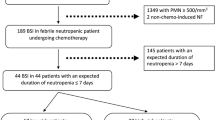Abstract
Objective of the present study was to describe the profile of infections in febrile neutropenia (FN) in acute leukemia and hematopoietic stem cell transplant (HSCT) with emphasis on response to therapy and outcome. In a prospective, observational single-institutional study, consecutive episodes of high-risk FN were enrolled over a 1½-year period. Uniform antibiotic policy and response criteria were used. Of the 200 episodes enrolled, acute leukemia induction comprised 40.5%, consolidation with high-dose cytarabine 22.5%, HSCT 29% (auto-HSCT 84%), and others 8% of the episodes, respectively. Microbiologically documented infections comprised 30% episodes, while bacteremia was documented in 26% episodes. Gram-negative isolates were more common (55.7%). Cefoperazone–sulbactam had the highest in vitro efficacy against Gram-negative rods. Carbapenem resistance was most prevalent among Acinetobacter spp. (80%) and Pseudomonas aeruginosa (50%). All Gram-positive cocci other than enterococci were susceptible to vancomycin, while 2/8 enterococci were resistant to it. Cefoperazone–sulbactam and amikacin were used as first-line antibiotics. Overall mortality was 8%. On multivariate analysis, mortality was associated with a nadir leukocyte count < 200/μl and an abnormal chest radiograph. Among high-risk FN patients, inspite of a high-level of resistance to antibiotics, a frontline regime containing cefoperazone–sulbactam could restrict the use of imipenem and resulted in an acceptable mortality of 8%.

Similar content being viewed by others
References
Schimpff S, Satterlee W, Young VM, Serpick A. Empiric therapy with carbenicillin and gentamicin for febrile patients with cancer and granulocytopenia. N Engl J Med. 1971;284:1061–5.
Klastersky J, et al. Bacteraemia in febrile neutropenic cancer patients. Int J Antimicrob Agents. 2007;30:S51–9.
De Bock R, et al. Incidence of single agent Gram-negative bacteremias (SAGNB) in neutropenic cancer patients (NCP) in EORTC-IATG trials of empirical therapy for febrile neutropenia [abstract L-773]. In: Program and abstracts of the 41st Interscience Conference on Antimicrobial Agents and Chemotherapy (Chicago). Washington, DC: American Society for Microbiology, 2001:445.
Kanafani ZA, et al. Bloodstream infections in febrile neutropenic patients at a tertiary care center in Lebanon: a view of the past decade. Int J Infect Dis. 2007;11:450–3.
Baskaran ND, Gan GG, Adeeba K, Sam IC. Bacteremia in patients with febrile neutropenia after chemotherapy at a university medical center in Malaysia. Int J Infect Dis. 2007;6:513–7.
Hughes WT, et al. 2002 Guidelines for the use of antimicrobial agents in neutropenic patients with cancer. Clin Infect Dis. 2002;34:730–51.
National Comprehensive Cancer Network. NCCN clinical practice guidelines in oncology: prevention and treatment of cancer-related infections (v2.2009). Available online at www.nccn.org/professionals/physician_gls/PDF/infections.pdf (Accessed 16 Decemeber 2010).
Mathur P, Chaudhry R, Kumar L, Kapil A, Dhawan B. A study of bacteremia in febrile neutropenic patients at a tertiary-care hospital with special reference to anaerobes. Med Oncol. 2002;19:267–72.
Bakhshi S, Padmanjali KS, Arya LS. Infections in childhood acute lymphoblastic leukemia: an analysis of 222 febrile neutropenic episodes. Pediatr Hematol Oncol. 2008;25:385–92.
Gupta A, et al. Infections in acute myeloid leukemia: an analysis of 382 febrile episodes. Med Oncol. 2010;27:1037–45.
Prabhash K, et al. Blood stream infections in cancer patients: a single center experience of isolates and sensitivity pattern. Indian J Cancer. 2010;47:184–8.
Klastersky J, et al. The Multinational association for supportive care in cancer risk index: a multinational scoring system for identifying low-risk febrile neutropenic cancer patients. J Clin Oncol. 2000;18:3038–51.
Kuderer NM, Dale DC, Crawford J, Cosler LE, Lyman GH. Mortality, morbidity and cost associated with febrile neutropenia in adult cancer patients. Cancer. 2006;106:2258–66.
Ascioglu S, et al. The invasive fungal infections cooperative group of the european organization for research and treatment of cancer and mycoses study group of the national institute of allergy and infectious diseases. Defining opportunistic invasive fungal Infections in immunocompromised patients with cancer and hematopoietic stem cell transplants: an international consensus. Clin Infect Dis. 2002;34:7–14.
Jagarlamudi R, et al. Infections in acute leukemia: an analysis of 240 febrile episodes. Med Oncol. 2000;17:111–6.
Varaiya A, Kulkarni M, Bhalekar P, Dogra J. Incidence of carbapenem-resistant Pseudomonas aeruginosa in diabetes and cancer patients. Indian J Med Microbiol. 2008;26:238–40.
Winston DJ, Ho WG, Bruckner DA, Gale RP, Champlin RE. Controlled trials of double beta-lactam therapy with cefoperazone plus piperacillin in febrile granulocytopenic patients. Am J Med. 1988;85:21–30.
Mortimer J, Miller S, Black D, Kwok K, Kirby WM. Comparison of cefoperazone and mezlocillin with imipenem as empiric therapy in febrile neutropenic cancer patients. Am J Med. 1988;85:17–20.
Winston DJ, Ho WG, Bruckner DA, Champlin RE. Beta-lactam antibiotic therapy in febrile granulocytopenic patients. A randomized trial comparing cefoperazone plus piperacillin, ceftazidime plus piperacillin, and imipenem alone. Ann Intern Med. 1991;115:849–59.
Bodey G, Abi-Said D, Rolston K, Raad I, Whimbey E. Imipenem or cefoperazone-sulbactam combined with vancomycin for therapy of presumed or proven infection in neutropenic cancer patients. Eur J Clin Microbiol Infect Dis. 1996;15:625–34.
Lazarus HM, et al. Cefoperazone/sulbactam versus cefoperazone plus mezlocillin: empiric therapy for febrile, neutropenic bone marrow transplant patients. Int J Antimicrob Agents. 1996;7:85–91.
Winston DJ, Bartoni K, Bruckner DA, Schiller GJ, Territo MC. Randomized comparison of sulbactam/cefoperazone with imipenem as empirical monotherapy for febrile granulocytopenic patients. Clin Infect Dis. 1998;26:576–83.
Chandrasekar PH. Safety and efficacy of cefoperazone plus sulbactam versus ceftazidime in the empiric treatment of febrile neutropenia. J Pharm Technol. 1998;14:63–9.
Ozyilkan O, Yalçintaş U, Başkan S. Imipenem-cilastatin versus sulbactam-cefoperazone plus amikacin in the initial treatment of febrile neutropenic cancer patients. Korean J Intern Med. 1999;14:15–9.
Ziglam HM, Gelly K, Olver W. A survey of the management of neutropenic fever in oncology units in the UK. Int J Antimicrob Agents. 2007;29:430–3.
Conflicts of interest
None.
Author information
Authors and Affiliations
Corresponding author
Rights and permissions
About this article
Cite this article
Ghosh, I., Raina, V., Kumar, L. et al. Profile of infections and outcome in high-risk febrile neutropenia: experience from a tertiary care cancer center in India. Med Oncol 29, 1354–1360 (2012). https://doi.org/10.1007/s12032-011-9858-3
Received:
Accepted:
Published:
Issue Date:
DOI: https://doi.org/10.1007/s12032-011-9858-3




